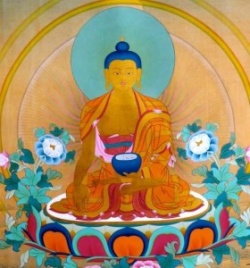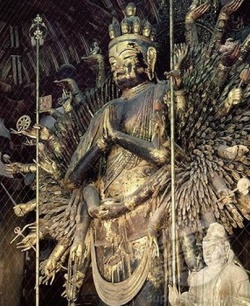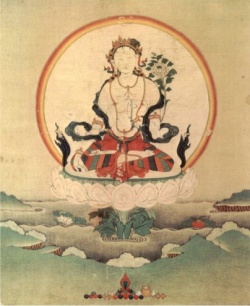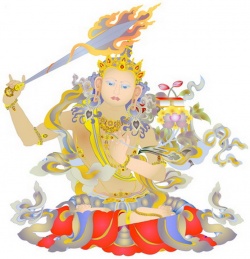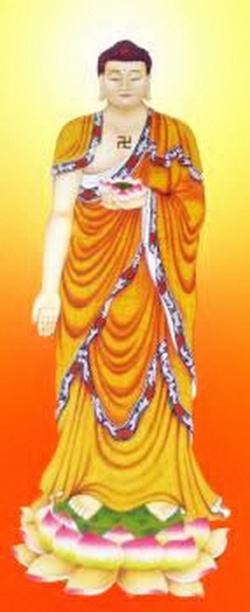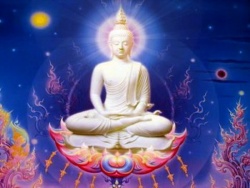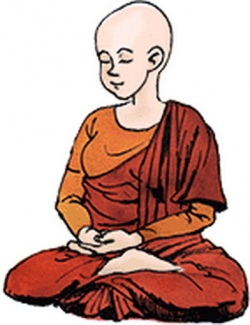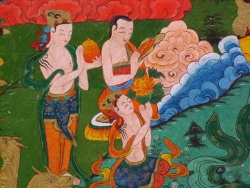Arthashastra
The Arthashastra (IAST: Arthaśāstra) is an ancient Indian treatise on statecraft, economic policy and military strategy which identifies its author by the names 'Kautilya' and 'Viṣhṇugupta', both names that are traditionally identified with Chāṇakya (c. 350–283 BC), who was a scholar at Takshashila and the teacher and guardian of Emperor Chandragupta Maurya, the founder of Mauryan Empire.
Date and authorship
The author of the Arthashastra refers to himself as 'Kautilya', while the last verse mentions the name 'Vishnugupta'. Many scholars believe that the former was the gotra of the author, while the latter was his personal name. Most scholars, though not all, also believe that these names refer to the 4th century BC scholar Chāṇakya. Thus, the original identification of Kautilya or Vishnugupta with the Mauryan minister Chanakya would date the Arthaśāstra to the 4th century BCE.
Some scholars believe that Arthasastra was written at a later stage. Their arguments include the assertion that the state described in Arthasastra is smaller than the Maurya empire, and there is no reference to either the empire or its capital Pataliputra. In addition, some of the geographical place names, the reference to the Hunas and the use of the Greek loan words suggest a later date. Thomas R. Trautmann and I.W. Mabbett have hypothesized that the 'Arthaśāstra' is a composition from no earlier than the 2nd century AD, but is clearly based on earlier material. Their explanation is that while the doctrines of the 'Arthaśāstra' may have been written by Chanakya in the 4th century BC, the treatise we know today may have been edited or condensed by another author in the 2nd century AD. This would explain, some affinities with smrtis and references in the Arthaśāstra which would be anachronistic for the 4th century BC. Trautmann believes that Arthashastra is actually a compilation of a number of earlier texts written by various authors, and Chanakya might have been 'one of these authors.
K.C. Ojha has put forward the view attributing the doctrines of 'Arthaśāstra' to Kautilya or Chanakya and suggests that Vishnugupta is in fact a redactor of the original work. Thomas Burrow goes even further and says that Chanakya and Kautilya are actually two different people. However, some doubt about Burrow's assertion is due to the end of the treatise, which says: "This Sástra has been made by him who from intolerance (of misrule) quickly rescued the scriptures and the science of weapons and the earth which had passed to the Nanda king." This supports the more commonly held belief that Kautilya and Chanakya are the same person, given Chanakya's role as mentor to Chandragupta Maurya.
More recently, Mital concluded that the methods used by Trautmann were inadequate to prove his claims, and therefore "there exists no direct evidence against Kautilya being the sole author of The Arthashastra, nor evidence that it was not written during the 4th century BCE.". Mital goes on to rebut Trautmann's reliance on the affinity with the smrtis.
Noted Indian scholars such as Dr RC Majumdar, Dr DR Bhandarkar, Dr KP Jayaswal and Dr AS Altekar place the date of the Arthshastra between 7th century BC to 2nd century BC. Dr RK Mookerji, Prof FW Thomas and Vincent Arthur Smith all agree with the 4th century BC as the time of the book's composition. HC Raychoudhuri puts 249BC as the lower limit and 100AD as the upper limit of composition of the text of the Arthshastra in its present form and postulates that the original text dates from an earlier period. Sir RG Bhandarkar dated the composition of the current treatise to around 1st or 2nd century AD. This view is also held by some Western scholars but scholars such as DR RC Majumdar and Vincent Arthur Smith have rejected the date of Arthshastra as late as 2nd century AD and cite evidence that supports the composition of the Arthshastra in 4th century BC. DD Kosambi, noted historian and Indologist, maintains that the book is a 4th BC century creation by Chanakya or Kautilya who was Prime Minister of Chandragupta Maurya. Prof Romilla Thapar believes that the book is a geniune text dating from Mauryan India (4th century BC) but given its final touch by an editor in 3rd century AD. She supports the view of Trautmann that portions were composed by Kautilya, but various sections were composed or edited later and the treatise was given its present day form in 3rd century AD. Trautmann notes that some portions of the treatise were probably composed by Kautilya, who was the Prime Minister of Chandragupta, but that other parts were added later on. He dates the composition of Book-2 of the 'Arthaśāstra' to 150CE and the whole treatise in its present form by 250CE.
In summary, most scholars put the composition of the 'Arthaśāstra' to between 4th century BC and 2nd century AD. The text was influential until the 12th century, when it disappeared. It was discovered in 1904 by R. Shamasastry, who published it in 1909 and the first English translation was published in 1915.
Translation of the title
Different scholars have translated the word "arthaśāstra" in different ways.
R.P. Kangle – "science of politics," a treatise to help a king in "the acquisition and protection of the earth."
A.L. Basham – a "treatise on polity"
D.D. Kosambi – "science of material gain"
G.P. Singh – "science of polity"
Roger Boesche – "science of political economy"
Roger Boesche describes the Arthaśāstra as "a book of political realism, a book analysing how the political world does work and not very often stating how it ought to work, a book that frequently discloses to a king what calculating and sometimes brutal measures he must carry out to preserve the state and the common good."
Centrally, Arthaśāstra argues how in an autocracy an efficient and solid economy can be managed. It discusses the ethics of economics and the duties and obligations of a king. The scope of Arthaśāstra is, however, far wider than statecraft, and it offers an outline of the entire legal and bureaucratic framework for administering a kingdom, with a wealth of descriptive cultural detail on topics such as mineralogy, mining and metals, agriculture, animal husbandry, medicine and the use of wildlife. The Arthaśāstra also focuses on issues of welfare (for instance, redistribution of wealth during a famine) and the collective ethics that hold a society together.
Comparison to Machiavelli
Because of its harsh political pragmatism, the Arthashastra has often been compared to Machiavelli's The Prince.
Is there any other book that talks so openly about when using violence is justified? When assassinating an enemy is useful? When killing domestic opponents is wise? How one uses secret agents? When one needs to sacrifice one's own secret agent? How the king can use women and children as spies and even assassins? When a nation should violate a treaty and invade its neighbor? Kautilya — and to my knowledge only Kautilya — addresses all those questions. In what cases must a king spy on his own people? How should a king test his ministers, even his own family members, to see if they are worthy of trust? When must a king kill a prince, his own son, who is heir to the throne? How does one protect a king from poison? What precautions must a king take against assassination by one's own wife? When is it appropriate to arrest a troublemaker on suspicion alone? When is torture justified? At some point, every reader wonders: Is there not one question that Kautilya found immoral, too terrible to ask in a book? No, not one. And this is what brings a frightful chill. But this is also why Kautilya was the first great, unrelenting political realist.
—Boesche (2002, p. 1)
Max Weber observed
Truly radical 'Machiavellianism', in the popular sense of that word, is classically expressed in Indian literature in the Arthasastra of Kautilya (written long before the birth of Christ, ostensibly in the time of Chandragupta): compared to it, Machiavelli’s The Prince is harmless.
—Max Weber, Politics as a Vocation (1919)
However, these aspects form just one of the 15 books that comprise the 'Arthaśāstra'. The scope of the work is far broader than popular perceptions indicate, and in the treatise can also be found compassion for the poor, for servants and slaves, and for women. For instance, Kautilya advocates what is now known as land reform, and elsewhere ensures the protection of the chastity of female servants or prisoners. Significant portions of the book also cover the role of dharma, welfare of a kingdom's subjects and alleviating hardship in times of disaster, such as famine.
Books of Arthashastra
Arthashastra is divided into 15 books:
Concerning Discipline
The Duties of Government Superintendents
Concerning Law
The Removal of Thorns
The Conduct of Courtiers
The Source of Sovereign States
The End of the Six-Fold Policy
Concerning Vices and Calamities
The Work of an Invader
Relating to War
The Conduct of Corporations
Concerning a Powerful Enemy
Strategic Means to Capture a Fortress
Secret Means
The Plan of a Treatise
The Rajarshi
Arthashastra deals in detail with the qualities and disciplines required for a Rajarshi – a wise and virtuous king.
"In the happiness of his subjects lies the king's happiness, in their welfare his welfare. He shall not consider as good only that which pleases him but treat as beneficial to him whatever pleases his subjects" – Kautilya.
According to Kautilya, a Rajarshi is one who:
Has self-control, having conquered the inimical temptations of the senses;
Cultivates the intellect by association with elders;
Keeps his eyes open through spies;
Is ever active in promoting the security and welfare of the people;
Ensures the observance (by the people) of their dharma by authority & example;
Improves his own discipline by (continuing his) learning in all branches of knowledge; and
Endears himself to his people by enriching them and doing good to them.
Such a disciplined king should: –
Keep away from another's wife;
Not covet another's property;
Practice ahimsa (non-violence towards all living things);
Avoid day dreaming, capriciousness, falsehood and extravagance; and
Avoid association with harmful persons and indulging in (harmful) activities.
Kautilya says that artha (Sound Economies) is the most important; dharma and karma are both dependent on it. A Rajarshi shall always respect those councillors and purohitas who warn him of the dangers of transgressing the limits of good conduct, reminding him sharply (as with a goad) of the times prescribed for various duties and caution him even when he errs in private.
Duties of the king
If the king is energetic, his subjects will be equally energetic. If he is lax (and lazy in performing his duties), the subjects will also be lax and thereby eat into his wealth. Besides, a lazy king will easily fall into the hands of enemies. Hence the Rajarshi should himself always be energetic. He shall divide the day and the night, each into eight periods of one and half hours, and perform his duties as follows:
First 1½ hrs. after sunrise Receive reports on defence, revenue, expenditure
Second 1½ hrs. after sunrise Public audiences, to hear petitions of city and country people
Third 1½ hrs. after sunrise and Last 1½ hrs. before noon Receive revenues and tributes; appoint ministers and other high officials & allot tasks to them
First 1½ hrs. after noon Write letters & dispatches, confer with councillors, receive secret information from spies
Second 1½ hrs. after noon Personal: recreation, time for contemplation
Third 1½ hrs. after noon and Last 1½ hrs. before sunset Inspect and review forces; Consult with Chief of Defence
The day shall end with evening prayers.
First 1½ hrs. after sunset Interview with secret agents
Second 1½ hrs. after sunset Personal: bath, meals, study
Third & Fourth 1½ hrs. after sunset and First 1½ hrs. after midnight Retire to the bed chamber to the sound of music, sleep
Second 1½ hrs. after midnight After waking to the sound of music, meditate on political matters and on work to be done
Third 1½ hrs. after midnight Consult with councilors, send out spies
Last 1½ hrs. before sunrise Religious, household & personal duties, meetings with his teacher, adviser on rituals, purohitas, personal physician, chief cooks and astrologer
Or some other time table which suits the king.
Hence the king shall be ever active in the management of the economy. The root of wealth is (economic) activity and lack of it (brings) material distress. In the absence of (fruitful economic) activity, both current prosperity and future growth will be destroyed. A king can achieve the desired objectives and abundance of riches by undertaking (productive) economic activity.
An ideal king is one who has the highest qualities of leadership, intellect, energy & personal attributes.
The qualities of leadership (which attracts followers) are: birth in a noble family, good fortune, intellect and prowess, association with elders, being righteous, truthful, resolute, enthusiastic and disciplined, not breaking his promises, showing gratitude (to those who help him), having lofty aims, not being dilatory, being stronger than neighbouring kings and having ministers of high quality.
The qualities of intellect are: desire to learn, listening (to others), grasping, retaining, understanding thoroughly and reflecting on knowledge, rejecting false views and adhering to the true ones. An energetic king is one who is valorous, determined, quick, and dexterous. As regards personal attributes, an ideal king should be eloquent, bold and endowed with sharp intellect, a strong memory and a keen mind. He should be amenable to guidance. He should be well trained in all the arts and be able to lead the army. He should be just in rewarding and punishing. He should have the foresight to avail himself of the opportunities (by choosing) the right time, place and type of action. He should know how to govern in normal times and in times of crisis. He should know when to fight and when to make peace, when to lie in wait, when to observe treaties and when to strike at an enemy's weakness. He should preserve his dignity at all times and not laugh in an undignified manner. He should be sweet in speech, look straight at people and avoid frowning. He should eschew passion, anger, greed, obstinacy, fickleness and backbiting. He should conduct himself in accordance with advice of elders.
Internal strife
Kautilya says – Quarrels among people can be resolved by winning over the leaders or by removing the cause of the quarrel – people fighting among themselves help the king by their mutual rivalry. Conflicts (for power) within the royal family, on the other hand, bring about harassment and destruction to the people and double the exertion that is required to end such conflicts. Hence internal strife in the royal family for power is more damaging than quarrels among their subjects. The king must be well versed in discretion and shrewd in judgement.
Comments on vices
Vices are corruptions due to ignorance and indiscipline; an unlearned man does not perceive the injurious consequences of his vices. He summarizes: subject to the qualification that gambling is most dangerous in cases where power is shared, the vice with the most serious consequence is addiction to drink, followed by, lusting after women, gambling, and lastly hunting.
Training of a future king
Importance of self-discipline Discipline is of two kinds – inborn and acquired. (There must be an innate capacity for self-discipline for the reasons given below). Instruction & training can promote discipline only in a person capable of benefiting from them, people incapable of (natural) self-discipline do not benefit. Learning imparts discipline only to those who have the following mental facilities – obedience to a teacher, desire and ability to learn, capacity to retain what is learnt, understanding what is learnt, reflecting on it and (finally) ability to make inferences by deliberating on the knowledge acquired. Those who are devoid of such mental faculties are not benefited (by any amount of training) One who will be a king should acquire discipline and follow it strictly in life by learning the sciences from authoritative teachers.
The training of a prince With improving his self-discipline, he should always associate with learned elders, for in them alone has discipline its firm roots. For a trained intellect ensues yoga (successful application), from yoga comes self-possession. This is what is meant by efficiency in acquiring knowledge. Only a king, who is wise, disciplined, devoted to a just governing of the subjects & conscious of the welfare of all beings, will enjoy the earth unopposed.
Seven ways to greet a neighbour
Kautilya recommended seven strategies in dealing with neighboring powers to Chandragupta Maurya.
The strategies are:
Sanman – Appeasement, non-aggression pact
Daam – Gift, bribery
Danda – Strength, punishment
Bheda – Divide, split, separating opposition
Maya – Illusion, deceit
Upeksha – Ignoring the enemy
Indrajala – Faking military strength
Maintenance of law and order
A conducive atmosphere is necessary for the state's economy to thrive. This requires that a state's law and order be maintained. Arthashastra specifies fines and punishments to support strict enforcement of laws. The science of law enforcement is also called Dandaniti.
Wildlife and forests
The Mauryas firstly looked at forests as a resource. For them, the most important forest product was the elephant. Military might in those times depended not only upon horses and men but also battle-elephants; these played a role in the defeat of Seleucus Nicator, Alexander's governor of the Punjab. The Mauryas sought to preserve supplies of elephants since it was more cost and time-effective to catch, tame and train wild elephants than raise them. Kautilya's Arthashastra unambiguously specifies the responsibilities of officials such as the Protector of the Elephant Forests:
On the border of the forest, he should establish a forest for elephants guarded by foresters. The Superintendent should with the help of guards...protect the elephants whether along on the mountain, along a river, along lakes or in marshy tracts...They should kill anyone slaying an elephant.
—Arthashastra
The Kauthilayas Arthashastra also reveals that the Mauryas designated specific forests to protect supplies of timber, as well as lions and tigers, for skins. Elsewhere the Protector of Animals also worked to eliminate thieves, tigers and other predators to render the woods safe for grazing cattle.
Economic ideas
The exhaustive account of the economic ideas embedded in the Arthashastra has been given by Ratan Lal Basu and by many renowned Arthasastra-experts in an Edited Volume by Sen & Basu This book contains papers presented by authors from all over the world in the International Conference held in 2009 at the Oriental Research Institute, Mysore, India to celebrate the Centenary of discovery and the first sanskrit translation of the manuscript of the Arthashastra by R. Shamasastry.
Recognition
Arthashastra is serious manual on statecraft, on how to run a state, informed by a higher purpose, clear and precise in its prescriptions, the result of practical experience of running a state. It is not just a normative text but a realist description of the art of running a state.
Shiv Shankar Menon, National Security Advisor
In October 2012, after about two thousand years from its composition, India's National Security Advisor Shiv Shankar Menon praised Arthashastra for its clear and precise rules which apply even today. Furthermore, he recommended reading of the book for broadening the vision on strategic issues.
